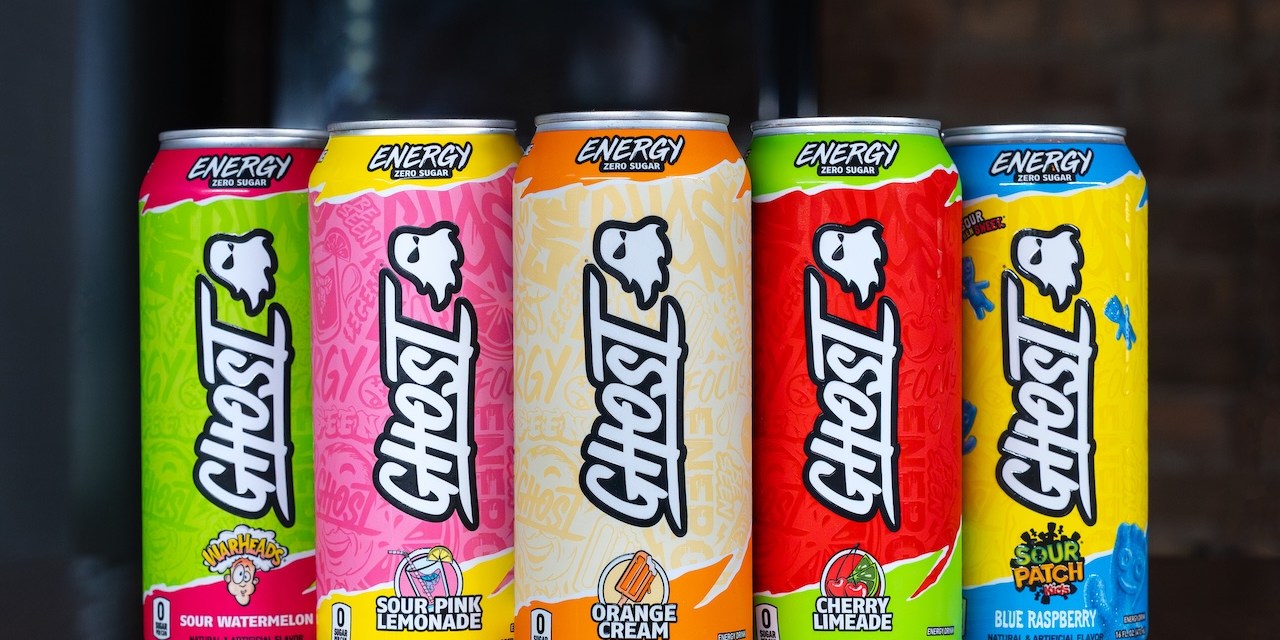Ghost is betting on on-premise sales to boost its energy drink business

Coming off of its $1 billion sale to Keurig Dr Pepper last year, beverage startup Ghost is embarking on its next growth phase.
A key part of this growth phase is increased on-premise distribution of the brand’s energy drinks to restaurants and bars, as well as music and sports venues. Ghost launched in 2018, and was historically known for its pre-workout powders and hydration products. But Ghost’s energy drink line, which launched in 2020, has since become Ghost’s top-selling segment; in turn, Ghost’s revenue quadrupled between 2021 and 2024, leading up to its sale to Keurig Dr Pepper.
Coming out of the pandemic, Ghost began distributing the energy drink cans at music venues and festivals in late 2021. Since then, Ghost has signed on over 20 major music festivals nationwide. This year, Ghost’s energy drink cans are being sold at Las Vegas’s T-Mobile Arena and The Venetian, among other venues. The brand also partnered with Warped Tour for the festival’s 2025 comeback tour.
In an interview with Modern Retail, Ghost co-founder and CEO Dan Lourenco said that Ghost is trying to build a more deliberate approach in this channel and is prioritizing a set of relevant venues that reach Ghost’s target young audience. Through its presence at these spaces, Lourenco said, Ghost is trying to offer bespoke experiences such as creating signature cocktails using its energy drinks, building pop-up lounges and hosting sponsored parties.
According to Lourenco, “on-premise leads to off-premise” growth. That’s because on-premise channels boost brand awareness that, in turn, fuels local retail sales. Lourenco said they also provide insights that inform future product R&D. The following interview with Lourenco was lightly edited for length and clarity.
How did your on-premise business get started?
“There is a long history of on-premise integration in our category. So, selfishly, why would we not want our products enjoyed in an on-premise environment? There has really only been one or two brands dominant in that space. So when we launched the beverage arm in 2020, we started working with a lot of the big festivals, beginning in our own backyard here in Las Vegas with Life Is Beautiful. That was followed by When we were Young, which is a huge emo pop punk festival.
It quickly grew from there, and we started working with festivals as a way to get Ghost cans in front of a lot of people at once. The festival concessions’ early success was something we couldn’t ignore. We wanted to try to get Ghost in as many venues, restaurants, bars and stadiums as possible. That led us to attack this [channel] broadly, hire some great leadership who has been there before and build out an on-premise team.”
With so much competition, what does it take to build out and support an on-premise beverage business?
“Our focus on the festival side has been about going really deep with a few partners. For instance, Insomniac [Festival] has been an amazing partner of ours, with their roots being in dance music. We’re also partnered with EDC [Electric Daisy Carnival], Hard Summer, Day Trip Festival and Beyond Wonderland.
What I’ve found is that just signing a deal with a venue is not enough. Getting the foot in the door is hard enough; it’s an uphill climb. But once you get that sign that deal, it’s all about showing up and executing. So, we really want to focus on certain geographies and try to get as much real estate as we can in that condensed geography. That allows us to go there with menu features, merchandising, refrigerators, special events and promos. So, for example, if Warped Tour is in town, we can get involved and sponsor an after-party.”
How does offering energy drinks on-premise cater to the habits of Gen Z and millennials?
“Our customers [skew] heavily Gen Z and millennial, and we’re pretty proud of that broad range.
Gen Z wants a product that was built for them. There are also huge trends toward sugar-free, performance energy and flavor variety. You’re starting to see some of the bigger legacy brands mirroring some of those in their offerings in recent years. And there is a lot of data about Gen Z consuming less alcohol. Whether or not I subscribe to that, I don’t know yet. But what I can say is it’s important to provide a great option that can be an ingredient in a cocktail or just consumed on its own.”
Has serving Ghost energy on-premise informed other aspects of the business?
“On-premise also helps feed the off-premise sales. So for example, in the cities where we have a really good on-premise footprint, we overindex in the stores there.
Selling at venues also led to product innovation for us. One example of this is how I personally underestimated people loving the 8-ounce cans we sell at the festivals. These are half cans that have 100 mg of caffeine, whereas our big ones are 200. There are some 4-packs of 8-ounce cans out there, in a limited capacity, but they’re not really available in off-premise retail. Going into next year, we’re bringing these to market in convenience [stores]. It will be in the OG flavor that was launched on-premise and has been really successful there. So, on-premise being a source of innovation is something I didn’t see initially, but we’re excited about it.”
Do you foresee on-premise sales to become a major channel for Ghost?
“The goal is obviously to make it as big as possible so people can enjoy Ghost wherever they’re going. It’s definitely a little bit of a marketing channel and a way to get Ghost in somebody’s hands when they’re having a good time. Our off-premise business has a huge head start and a lot more doors — 7-Eleven and Speedway alone have 14,000 doors. We’re not anywhere close to that yet from an on-premise and food service perspective, but we’re growing there and that’s exciting.”

